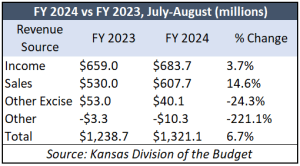August was the second month of calendar year 2023 in which Kansas’s state tax collections came in slightly below estimates. This doesn’t change the fact that the state has accumulated a Scrooge McDuck-sized pile of excess revenue that it should return to taxpayers.
Recent tax collection data

Despite August 2023 coming in below expectations across the board, FY 2024’s tax collections thus far are blowing FY 2023’s out of the water. For instance, income tax collections for FY 2024 were 1.7% below the prediction, but 3.7% higher than the actual income tax by this time in FY 2023. Similarly, sales tax was up from the predictions by 1.1%, but above the actual collections of last year by 14.6%. Taxes as a whole were down by 0.8% from prediction, but up 6.7% year over year So even though August was a subpar month, in fact, Kansas is still chugging ahead in excess revenue collections bolstered by July’s results.
According to the most-up-to-date estimates from the Consensus Revenue Estimating Group from April 2023, by FY 2024, Kansas is predicted to have a whopping $3.0 billion in its ending balance. An additional $1.6 billion is also predicted to be in the Budget Stabilization Fund to prevent deficits during any sort of economic shock.
The hefty balance comes from states across the country riding high tax intakes and excess revenue during the COVID-19 pandemic and beyond. Until November 2022, Kansas had 27 straight months of exceeding the expected tax revenue, often by huge margins. In October 2022, revenues were 11% over predictions and 11.7% higher than the actual amount in October 2021. FY 2023’s total tax collections were only 0.3% above predictions, but represented a $402 million increase compared to FY 2022.
What to do with the excess revenue?
Exceeding the tax collection expectations isn’t necessarily a bad thing: it would be alarming if Kansas had 27 straight months below expectations! However, the massive stockpile of excess funds is symptomatic of overtaxation. The state shouldn’t be sitting on billions of taxpayer dollars when they could be better used by the families and businesses that originally paid them.
The simplest way to do this would be a reduction in the income tax for everyone. An OECD study reports that after corporate income taxes, personal income taxes are the second most harmful tax to economic growth. According to an American Economic Association study, a 1 percentage point cut in taxes as a proportion of GDP increases GDP by 0.6 percent within one-quarter of the tax change, and by 2.5 percent after about three years. Small rate reductions to personal income taxes in Kansas would make the state more attractive for domestic migration. This makes perfect sense: an income tax actually taxes work. There is less incentive to earn income when more of that income is eaten away at by high tax rates.
Last year, a flat tax proposal on income failed despite the fact that the Consensus Estimating Group for Kansas released a budget profile that predicted a massive $3 billion ending surplus in FY 2024 WITH the flat tax included. Kansas can afford a tax reduction. The override of Governor Kelly’s veto failed short of the necessary votes more due to petty politics than actual debate.
Two basic guiding principles of tax reform are that:
- The tax reform has a significant long-term effect on growth and the economy to the benefit of taxpayers.
- The tax reform is applicable to everyone and applied fairly. Narrowly defined tax cuts rarely promote significant economic growth.
Rebates, credits, or corporate tax incentives largely consist of government picking who gets what – oftentimes inefficiently. During the high inflation of last year, many states were quick to offer rebates on gas or “gas tax holidays,” but these are economically insignificant in the long-run compared to structural tax reform. In fact, they go more towards boosting politicians’ approval than affecting the price at the pump for the future.
The debate between whether to reduce income taxes or sales taxes comes up frequently. Reducing the income tax results usually results in more long-term growth and is a more significant aspects in attracting new residents to the state. However, a sales tax cut is also important to keeping the cost of living low in communities across the state.
Kansas’s financial glut keeps growing with excess revenue. 2024 is the year that legislators need to find a way to give it back to taxpayers in a responsible manner to promote growth.



